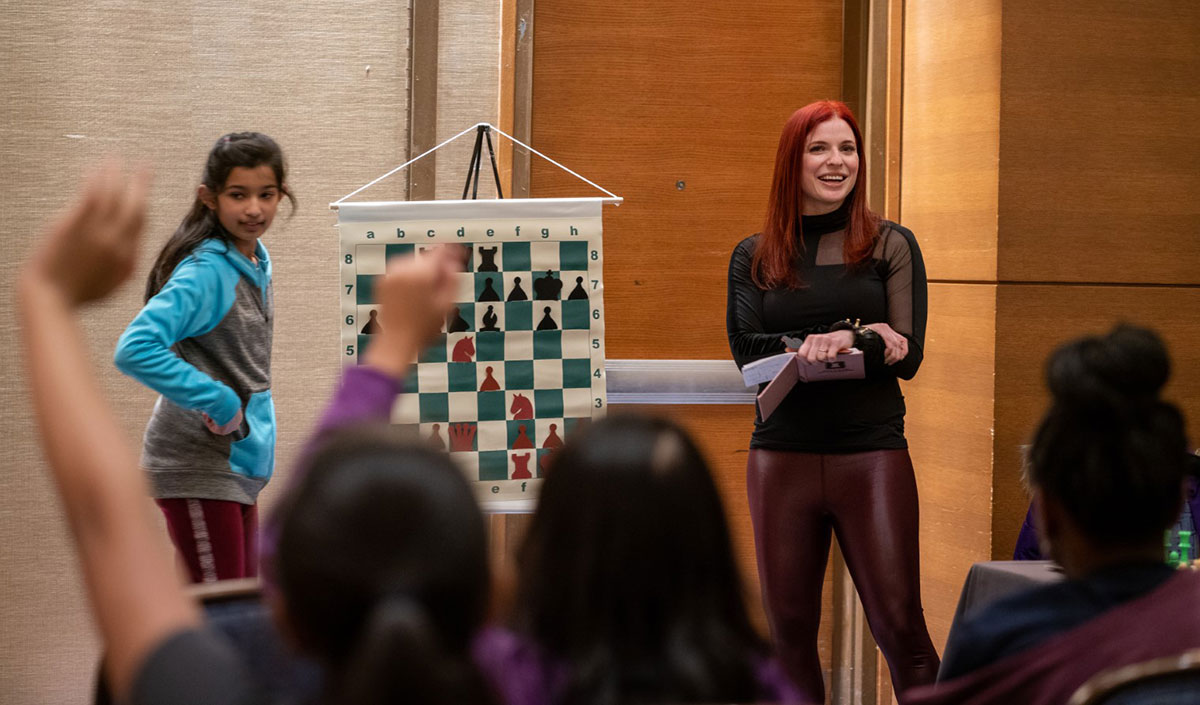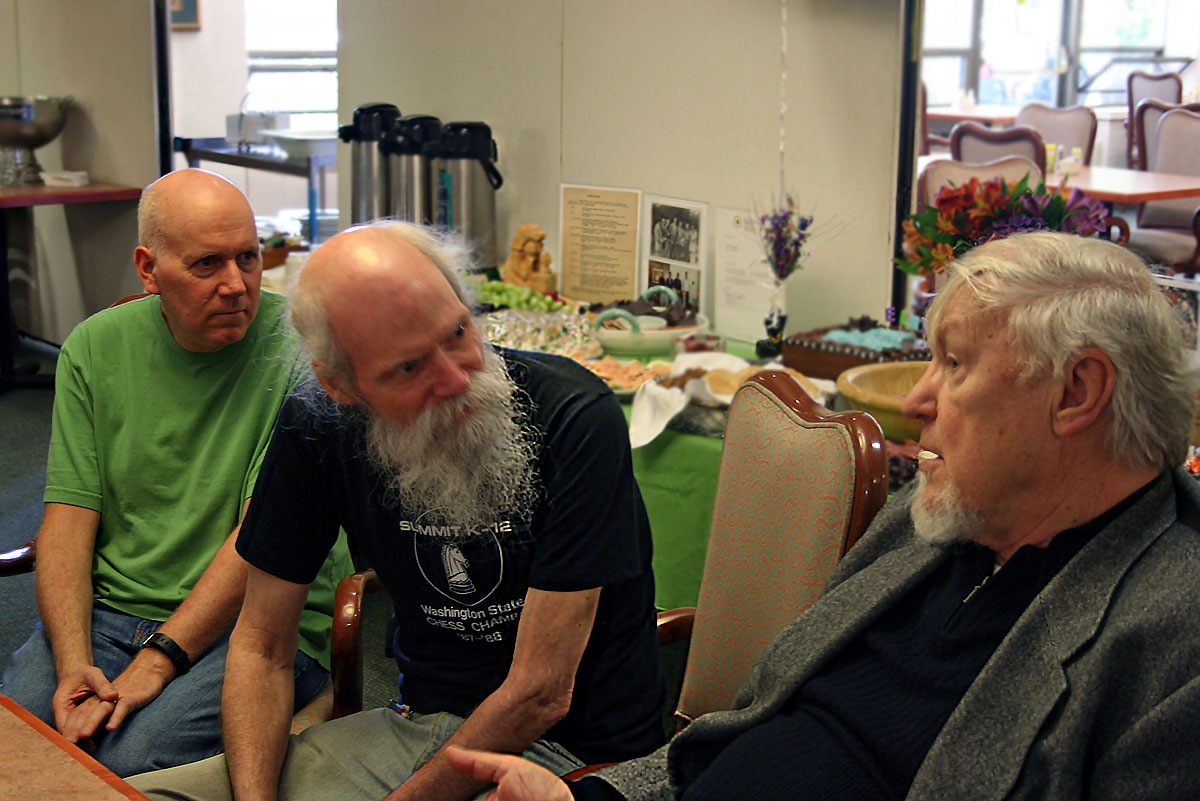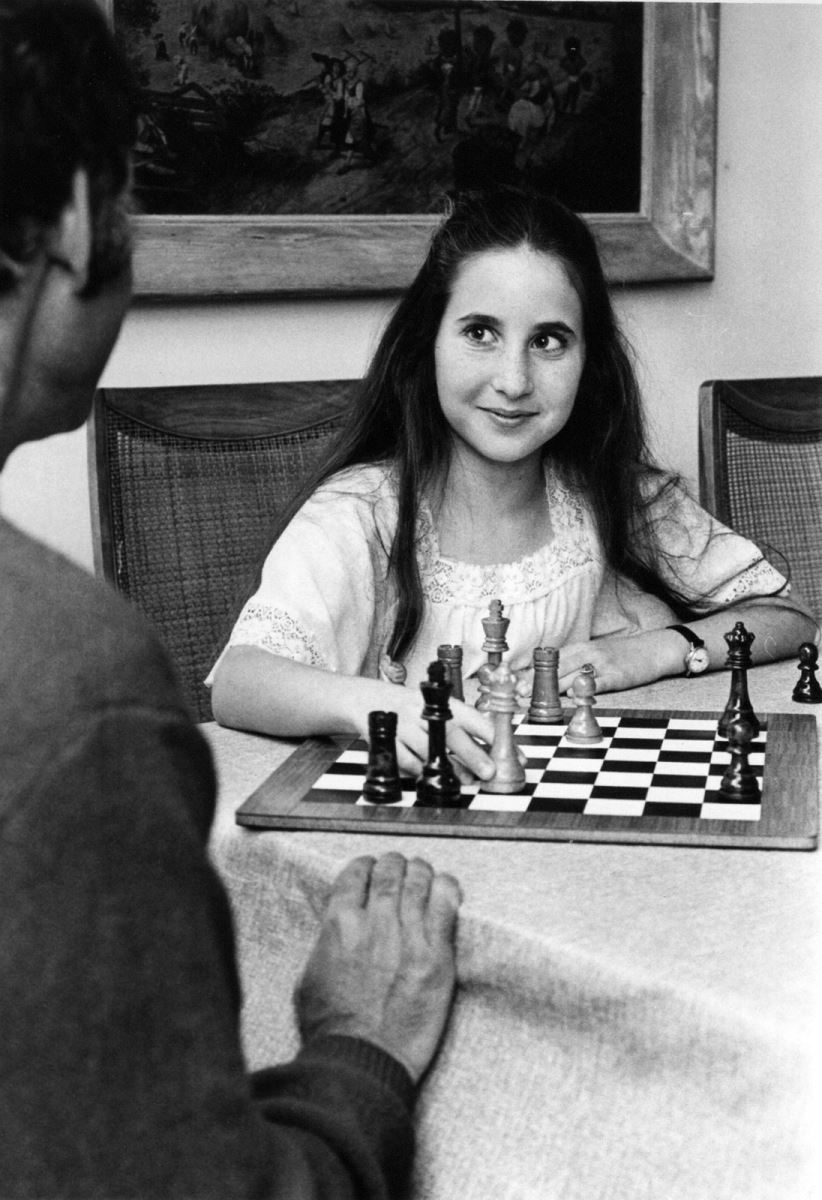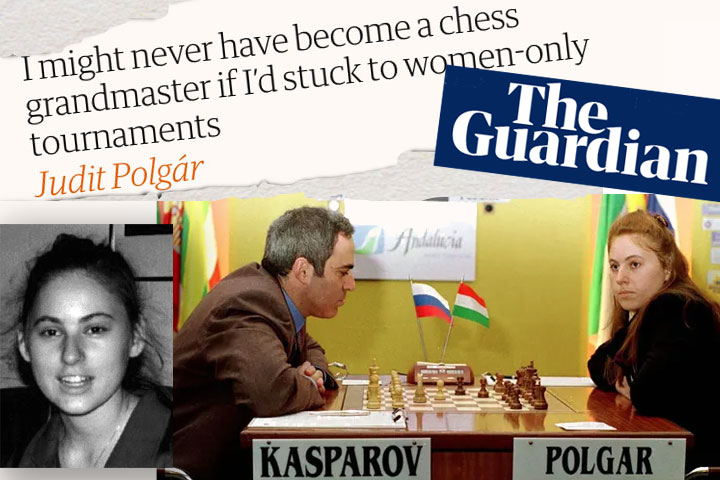Consequences of chess segregation
Grandmaster Judit Polgár’s editorial considers whether or not an increase in female-only chess competitions will lead to women and men competing “on an equal footing.” However, equal footing between women and men does not exist in the real world. The chess world overflows with sexist discourse. My reply to Polgár’s editorial considers how the real world and the chess world intertwine and whether Polgár’s perspective is colored by her being raised in a family that promoted chess achievement.
Segregated and co-ed environments
One analogy for segregated tournaments for girls and women could be to single-sex education, for example all-girls schools. Advocates of co-education argue, as Polgár did regarding chess, that separating girls may be harmful. According to Dr. Lise Eliot, single-sex education “increases discrimination and stereotyping.” Eliot also favorably cited a book, Playing with the boys: why separate is not equal in sports, which argued that “sex segregation in sports does not simply reflect sex difference, but actively constructs and reinforces stereotypes about sex.”
On the other hand, advocates for single-sex education claim that all-girls schools are more successful at educating females. “Females especially do better academically in single-sex schools and colleges across a variety of cultures...Single-sex schools help to improve student achievement.”
In co-ed chess classrooms, teachers treat boys and girls differently. In 2007, Elizabeth Spiegel (née Vicary) recounted to Jennifer Shahade, “Even though I call on both genders a similar amount, I found that I ask girls much easier questions. And honestly, often it was because I didn’t think they were capable of answering the harder ones and I didn’t want to embarrass them.” Shahade, now Women's Chess Program director for US Chess, replied, “I definitely also ask girls easier questions.”

Shahade speaking to a group of girls | Photo: Eric Rosen / US Chess
Similar teacher behaviors occurred in co-ed school classrooms. A National Education Association review of research cited a 1993 study in 100 elementary classrooms which found:
- Boys called out eight times as often as girls did. When a boy yelled out, the teacher ignored the “raise your hand” rule and usually praised his contribution. Girls who called out got reminders to raise their hands.
- Teachers valued boys’ comments more than girls’ comments. Teachers responded to girls with a simple nod or an OK, but they praised, corrected, helped, and criticized boys.
- Boys were encouraged to solve problems on their own, but teachers helped girls who were stuck on problems.
How some teachers treated girls’ comments in co-ed instructional situations is similar to how women fare at present in co-ed discourse. According to an article by journalist Susan Chira, published in 2017 in The New York Times, “Researchers consistently find that women are interrupted more and that men dominate conversations and decision-making, in corporate offices, town meetings, school boards and the United States Senate.”
Ask a more intelligent question
On December 8th, former World Chess Champion Garry Kasparov told Grand Chess Tour commentator Shahade to “ask a more intelligent question”. Shahade replied, “I’ll try” and she and her co-host Peter Svidler laughed.
Kasparov’s remark might be a good addition to Shahade’s artwork “Not particularly beautiful.” Describing that artwork in her article of October 17, 2019, Shahade wrote, “The white squares of our board are insults levied at top female chess players, including the title square, a YouTube comment about me, ‘She is Not Particularly Beautiful At All.’” Beyond discourse, other inequalities exist. A 2019 article lists “18 Ways Women Still Aren’t Equal to Men.”
Follow the money
Polgár wrote “national federations use their resources, and public subsidies are creating more female-only competitions.” From its start 80 years ago until the mid-1990s, US Chess (then USCF) bore financial responsibility for U.S. Women’s Chess Championships, without much sponsorship help. USCF held U.S. Women’s Chess Championships somewhat sporadically. For example, I played in the U.S. Women’s Chess Championship for the first time in 1981, and again in 1984 (the next time it was held), and again in 1986 (the next time it was held). I recounted requests to USCF for funding for U.S. Women’s Chess Championships and for Regional Women’s tournaments in a prior article.
From the mid-1990s onward, sponsors of U.S. Women’s Chess Championships included Interplay, the Seattle Chess Foundation (AF4C), and the Saint Louis Chess Club. According to Dan Lucas, US Chess Senior Director of Strategic Communication, most of the money allocated from US Chess to girls’ and women’s events, including the U.S. Women’s Chess Championship, currently comes from the Saint Louis Chess Club and from donors to the Women in Chess Initiative.
Perhaps a portion of this donated money would not have gone to chess, except for the opportunity to support girls and women. Some philanthropic donors specifically look to donate to initiatives for girls and women. The Femme Batale “raised over $10,000 for women and girls in chess.” Likely many Femme Batale donations happened because the event was by women, for women.
Media coverage, camaraderie, financial incentives
Segregated tournaments generate media coverage of chess girls and women, allow them to network and make friends with each other, and provide them with financial incentives to stay in chess. Media attention may make girls and women aware that others of their gender play chess. In a 2018 article for Sports Illustrated, John G. Zimmerman wrote that the Women’s World Chess Championship is a chance for media coverage for women in chess: “In an environment where female players are such a tiny minority, the tournament is an invaluable opportunity to show off talent and grow the game.”
The next Women’s World Chess Championship is January 3-26, 2020, giving media another opportunity to highlight women in chess. If there were no segregated tournaments for women and girls, media mentions of female chess players might be less frequent. Chess articles about top players, such as for the GCT Finals, usually feature men. There is only one woman, Hou Yifan, currently among the top 100 rated players in the world.
Ten years ago, Shahade presented several arguments for segregated tournaments, including media coverage of women playing chess, women making friends with each other, and financial incentives. She wrote, “Women’s tournaments & training allow an under-represented population in the chess world to make friends and helps organizers to promote women in chess to the media & community. Women’s tournaments can also give women financial incentives to stay in the game.” In 2019, the Eade Foundation quoted Shahade as similarly stating “women’s tournaments are great fun for competitors of all ages and levels and can often provide extra opportunities for women chess players to earn money, prestige and attention for their hard work.” Both making money and making friends with other women and girls is more challenging for females at open tournaments, as some “opens” may have only one woman or one girl playing. That woman or girl may feel isolated and drop out of chess.
World Championship aspirations
Segregated tournaments may lead to lowered aspirations, according to Judit Polgár. She wrote, “The higher your goals, the higher you reach.” She cited the example of Hou Yifan, who has won the Women’s World Chess Championship four times. Polgár implied that if Hou Yifan had not played so often in women’s chess tournaments, she might have moved closer, sooner, to the ultimate goal of World Chess Champion. Polgár came close to that ultimate goal. As she wrote, “It turned out that I was not able to become the overall world champion, but I always strived to fulfil this ambition – and at my peak, I was the eighth highest ranked player in the world.”
Yet Judit Polgár did play in gender-segregated tournaments on her way to #8 in the world; her last one was playing on the gold-medal winning 1990 Hungarian Women’s Olympiad team. Moreover, gender-segregated tournaments are not the only “segregated” tournaments in chess, as players seek intermediate victories on their paths to World Chess Champion. Like Hou Yifan’s four Women’s World Chess Championship titles, some men also win the same championship four times. Chess legend Viktors Pupols is a four-time Washington State chess champion.

Eric Tangborn, John Braley, Viktors Pupols | Deborah Petzal-Pupols
The photo shows him, at right, with two other former Washington State Chess Champions, Eric Tangborn (left) and John Braley (center), at a 2013 gathering.

Did repeatedly winning that title, awarded only to Washington State residents, dull Pupols’ desire for more renowned chess accomplishments? I think not; I believe every chess player, at least once in his or her life, dreams of becoming World Champion. I bet Viktors Pupols dreamed about it often, considering that he defeated Bobby Fischer in a tournament game.
I dreamed too. When I was 10 years old (pictured), and one of the top 50 players in the United States under age 13 (including boys and girls), Bud Narveson interviewed me for The Gambit, published by the Lincoln Chess Foundation (in Nebraska). He wrote that I said, “I hope to win the 13 and under title in the city tournament.” “Not the junior title?” Narveson asked. “Not this year,” I replied. Narveson wrote, “But her long-range goals are less modest. She aims to be world champion.” “Women’s world champion?” asked Narveson. Narveson reported that I “sniffed in disdain” before replying “World’s champion. Someday I hope to beat Bobby Fischer.”
Photo: Lincoln Journal Star
As a teenager, my aspirations were derailed by my Canadian chess coach. Equal footing does not exist for victims of this crime, as sexual abuse happens to 1 in 5 girls and to 1 in 20 boys.
Family support
Even if I had never met that Canadian chess coach, I might not have pursued becoming world chess champion. Though I had some promising chess achievements, for example becoming an expert at age 15, my parents discouraged me from pursuing chess further. Instead, I attended college. For middle-class girls in first-world countries, family pressure to go to college may be greater than it is on boys, who may be encouraged to achieve their “genius” potential in chess.
As Wei Ji Ma reported for ChessBase, parents are more likely to think of their boys as geniuses than think of their girls that way. He wrote, “Leslie and Cimpian’s study would suggest that the primary reason why women are not motivated to pursue chess or are discouraged by others is that they or people around them do not believe they have the brilliance everyone believes to be needed for success in chess. (Again, this is regardless of the extent to which brilliance is truly required.)”
Judit Polgár wrote, “I know from experience that it is amazingly powerful if your loved ones and your coach believe in your ability.” Along with most other chess players, I did not experience family chess support at a level equivalent to that enjoyed by Judit Polgár. Moreover, when I matriculated, there were not college chess programs equivalent to the one offered by The University of Texas at Dallas, which allows college students to pursue both educational and chess aspirations.
Segregated championships
Segregated championships exist, by age and/or geography (such as the 13 and under championship for the city of Lincoln, Nebraska or the Washington State Chess Championship), by gender (such as the U.S. Women’s Chess Championship), by age and gender (US Girls’ Junior Championship), and even by profession (U.S. Armed Forces Open Chess Championship). Along with the more common “open” tournaments, these segregated tournaments provide diverse opportunities to compete at chess as we progress toward becoming World Chess Champion.
Whatever is true about the benefits or deficits of segregated chess championships, Polgár’s goal of equal footing may be challenging to achieve in an unequal world where few enjoy the chess support experienced by Polgár and her sisters.


























